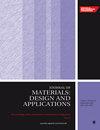A review on the fused deposition modelling of fibre-reinforced polymer composites: Influence of process parameters, pre-processing and post processing techniques
IF 2.2
4区 材料科学
Q3 MATERIALS SCIENCE, MULTIDISCIPLINARY
Proceedings of the Institution of Mechanical Engineers, Part L: Journal of Materials: Design and Applications
Pub Date : 2024-04-02
DOI:10.1177/14644207241243298
引用次数: 0
Abstract
Additive manufacturing is one of the latest manufacturing techniques that has gained universal recognition due to its material conservation nature. Fused deposition modelling (FDM) is an additive manufacturing technique that employs material extrusion to build components layer by layer. Thermoplastic polymers are used in FDM, and the components created are anisotropic and porous. Composite materials are used to improve the quality of the components. This article reviews recent research focused on the enhancement of the mechanical performance of composites produced by FDM. The influence of process parameters, type of fibre reinforcement (short and continuous fibres), pre-processing, process modification and post-processing techniques is analysed. Short fibres improved the mechanical performance of components, irrespective of the polymer matrix. Short fibres offered dimensional stability to the components, besides improving mechanical performance. Continuous fibres produce components with superior mechanical properties than short fibre composites. Continuous fibre reinforcement is the most effective reinforcement for fabricating structural and functional components in FDM. The importance of pre-processing, process modification and post-processing techniques in improving the mechanical characteristics of the components is discussed. In addition, this review identifies the significant challenges and perspectives for the future development of FDM technology in fibre-reinforced composites.纤维增强聚合物复合材料熔融沉积建模综述:工艺参数、预处理和后处理技术的影响
增材制造是最新的制造技术之一,因其节约材料的特性而得到了普遍认可。熔融沉积模型(FDM)是一种快速成型制造技术,它采用材料挤压的方式逐层制造部件。FDM 使用热塑性聚合物,制造出的部件具有各向异性和多孔性。复合材料可用于提高组件的质量。本文回顾了近期关于提高 FDM 复合材料机械性能的研究。文章分析了工艺参数、纤维增强类型(短纤维和连续纤维)、预处理、工艺修改和后处理技术的影响。无论聚合物基体如何,短纤维都能改善部件的机械性能。短纤维除了能提高机械性能外,还能为部件提供尺寸稳定性。与短纤维复合材料相比,连续纤维生产的部件具有更优越的机械性能。连续纤维增强材料是在 FDM 中制造结构和功能部件的最有效增强材料。本综述讨论了预处理、工艺改性和后处理技术在改善部件机械特性方面的重要性。此外,本综述还指出了 FDM 技术在纤维增强复合材料领域的重大挑战和未来发展前景。
本文章由计算机程序翻译,如有差异,请以英文原文为准。
求助全文
约1分钟内获得全文
求助全文
来源期刊

CiteScore
4.70
自引率
8.30%
发文量
166
审稿时长
3 months
期刊介绍:
The Journal of Materials: Design and Applications covers the usage and design of materials for application in an engineering context. The materials covered include metals, ceramics, and composites, as well as engineering polymers.
"The Journal of Materials Design and Applications is dedicated to publishing papers of the highest quality, in a timely fashion, covering a variety of important areas in materials technology. The Journal''s publishers have a wealth of publishing expertise and ensure that authors are given exemplary service. Every attention is given to publishing the papers as quickly as possible. The Journal has an excellent international reputation, with a corresponding international Editorial Board from a large number of different materials areas and disciplines advising the Editor." Professor Bill Banks - University of Strathclyde, UK
This journal is a member of the Committee on Publication Ethics (COPE).
 求助内容:
求助内容: 应助结果提醒方式:
应助结果提醒方式:


